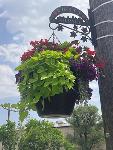By Claudio D'Intino
Before Finch Ave West extended passed Islington Ave, there was an access road just to the south that lead to 51 Panorama Court. As a child growing up in the 1970s to the east of Rowntree Mills Parks, I ventured up this access road, which is now Finch Islington Park. With the Finch Avenue extension to Kipling built in the early 1990s, this access road was permanently closed. On the Hiking the GTA website, it reads, “The former road on the south side of Finch Avenue has been reclaimed by the forest. New growth trees stand out in a strip between the mature pine trees on either side of the former roadway.”
I always wondered what the large private property called the Thistletown Regional Centre was all about. In 2011, I drove to the grounds via Kipling Ave to the Panorama Court entrance.
Denise Harris is with the Etobicoke Historical Society and has documented the centre’s history.
“This new branch of the Hospital for Sick Children was officially opened on Oct. 24, 1928...(it was) custom-designed for children requiring helio (sun) therapy or hospitalization for long periods, e.g. while recovering from rheumatic fever, osteomyelitis, polio or surgery...(and) accommodated 112 patients in rooms with 6 to 8 cots that could be wheeled outside in nice weather...(where) 50,000 tree seedlings and extensive gardens were planted on the grounds.”
Thistletown centre property was built on the 80 acres of farmland purchased from Francis and Arabella Kingdon and 10 acres from Henry and Elizabeth Barker. It had a water filtration system, sewage disposal system, steam plant and a bus shuttle.
In 1954, Hurricane Hazel caused a power failure and a decision was made to close the facility.
The Ontario government bought the property in 1957 and turned Thistletown into a residential mental health centre for children and youth. Over the years, the centre evolved with advances in child psychiatry, that included ten small houses constructed and a partnership with the Toronto District School Board.
The centre has had its fair share of unique challenges for both staff and clients. The property has been reduced to 36 acres. In 2014, despite protests, Thistletown was closed for good. It is now part of the City of Toronto inventory of heritage properties.
Over the past year, as part of the Provincial Affordable Housing Lands Program, 51 Panorama Court has put out a development land offering of 49 acres, through CBRE Land Services Group.
A Dec. 2018 Toronto Star article by Tess Kalinowski states, “...the sell-off of 243 surplus government properties on 14,600 acres...from old jails and psychiatric hospitals to empty lots.”
In 1847, Thistletown, was named after a local doctor, William Thistle, not for the prickly plant. The centre was an important chapter for the issue of mental health and children in Ontario.
The children treated in Thistletown over the years were looked as roses in our society, and not as thorns.














